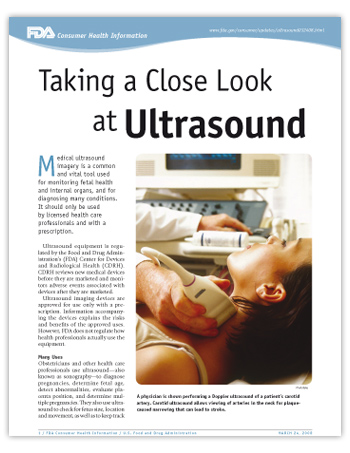For Consumers
A Close Look at Ultrasound
Printer-friendly PDF (414 KB) |
On this page:
Medical ultrasound imagery is a common and vital tool used for monitoring fetal health and internal organs, and for diagnosing many conditions. It should only be used by licensed health care professionals and with a prescription.
Ultrasound equipment is regulated by the Food and Drug Administration’s (FDA) Center for Devices and Radiological Health (CDRH). CDRH reviews new medical devices before they are marketed and monitors adverse events associated with devices after they are marketed.
Ultrasound imaging devices are approved for use only with a prescription. Information accompanying the devices explains the risks and benefits of the approved uses. However, FDA does not regulate how health professionals actually use the equipment.
Many Uses
Obstetricians and other health care professionals use ultrasound—also known as sonography—to diagnose pregnancies, determine fetal age, detect abnormalities, evaluate placenta position, and determine multiplepregnancies. They also use ultrasound to check for fetus size, location and movement, and to keep track of fetal breathing and heartbeat.
Other health care professionals use ultrasound to view the heart, blood vessels, kidneys, liver, and other organs of people of all ages.
Using ultrasound, doctors can check patients’ thyroid glands, diagnose certain infections and cancers, and find abnormalities in men’s prostate glands and scrotums. Carotid ultrasound allows viewing of arteries in the neck for plaque-caused narrowing that can lead to stroke.
The types of ultrasound imaging exams used to diagnose medical conditions include
• Doppler ultrasound, used to visualize flow through a blood vessel
• Bone sonography, which helps doctors diagnose osteoporosis
• Echocardiograms, which offer a view of the heart
A Safe Technology
Ultrasound, which was developed from sonar and radar technology, has earned an excellent safety record since being put into widespread use more than 30 years ago.
It generates images that can be captured in real-time and show movement of the body’s internal organs.The images can also be presented as still pictures.
Ultrasound uses non-ionizing radiation—energy levels that are not great enough to alter atoms and molecules and permanently damage biological tissues. Hence, it doesn’t present the same type of risks as x-rays or other types of ionizing radiation.
The technology uses high-frequency sound waves that reflect off of soft tissues
such as muscles and internal organs. The returning waves are read by a receiving device, which transforms them into a visual image.
Usually Painless
The sound waves of ultrasound imaging are transmitted by a hand-held device known as a transducer, which sends a beam of ultrasound into the body and then receives the reflected signal.
During most ultrasound exams, a doctor or a qualified technician moves the transducer over the skin covering the area of interest. The area of interest is covered before the procedure with a small amount of warm gel that helps keep air pockets from forming between the transducer and skin. An ultrasound exam is usually a painless procedure.
Some exams, called “invasive ultrasounds,” are done inside the body. A health care professional attaches a transducer to a probe that’s inserted into a natural opening in the body. This type of procedure can cause some discomfort or pain.
A typical ultrasound exam takes from 30 minutes to an hour. How a patient prepares for a procedure depends on the part of the body being examined.
There may be no special preparation required. However, a physician may instruct a patient not to eat food or drink liquids prior to the procedure.Some types of exams require the patient to have a full bladder. Patients should ask their doctors for full instructions on how to prepare for an ultrasound exam.
This article appears on FDA's Consumer Updates page, which features the latest on all FDA-regulated products.
Date Posted: March 24, 2008







